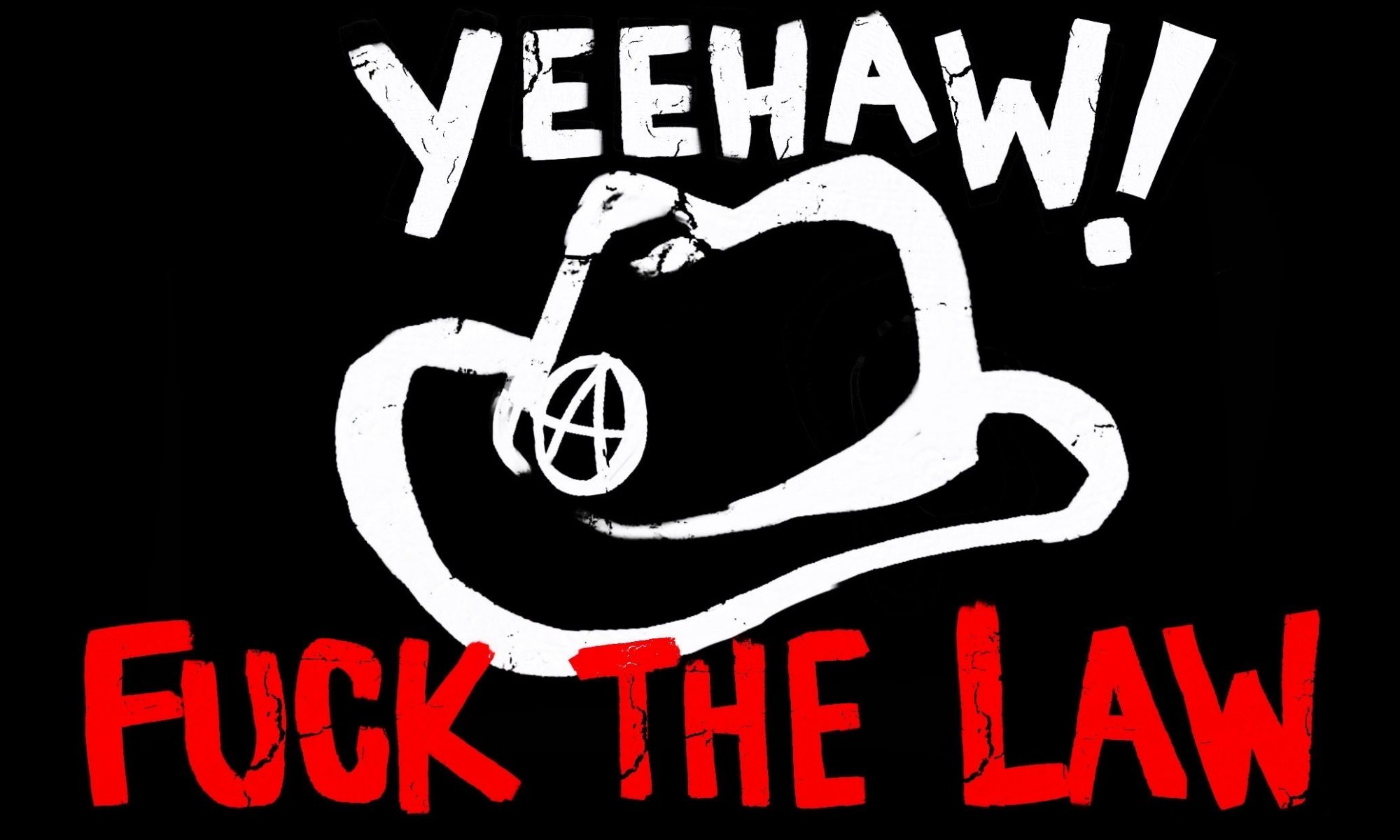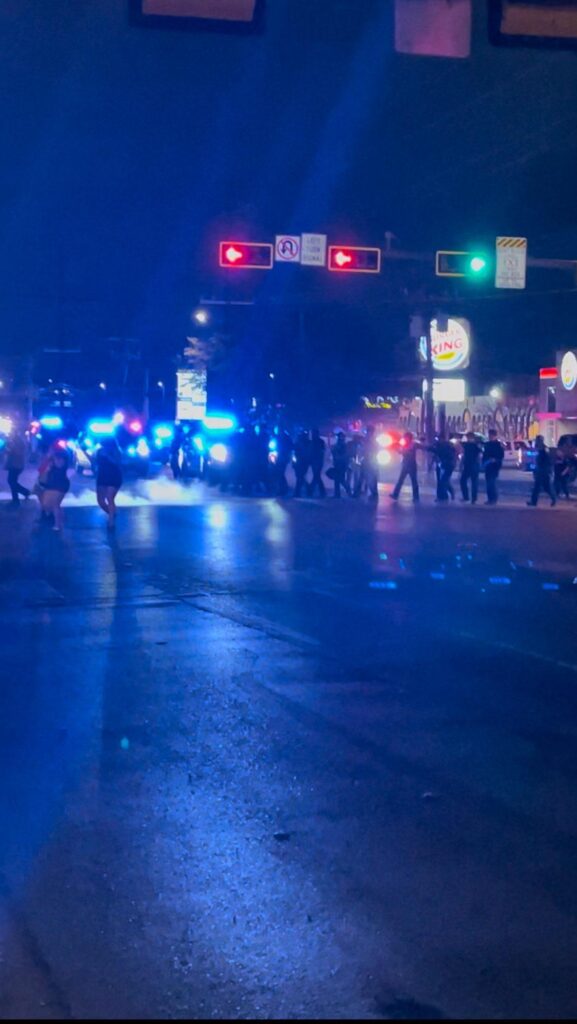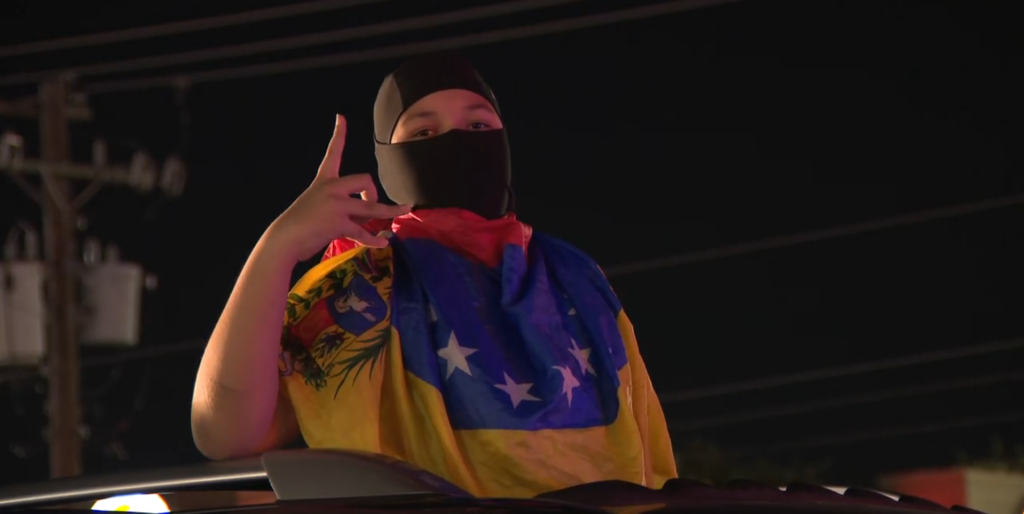An Anonymous transmission, with An editorial note from Austin Autonomedia:
In February 2017, a spontaneous protest in response to ICE raids under a Trump presidency evolved into a party/riot that took over the intersection at Rundberg and Lamar. In 2017, anarchists and revolutionaries participated and reflected on this experience.
In February 2025, a protest against ICE raids under a Trump presidency on Rundberg announced via TikTok evolved into a party/riot/sideshow that took over the intersection and Rundberg and Rutland. In 2025, anarchists and revolutionaries again participated in, and are now reflecting on this experience.
In this transmission, we see another round of reflections on an anti-ICE rebellion on Rundberg, which builds upon our previous collection of reflections on the 2017 Rundberg Rebellion. We encourage these reflections to be read together to draw out the similarities between the moments we find ourselves in, and their differences. It is rare that we get to reflect on, compare, and contrast such similar conditions and truly consider, and actualize, what we might do differently. Some of the similarities are obvious–the location, the ways people slowly progressed from a sign-holding rally to a party that overtook the intersection itself. We might imagine that the location was not accidental, but that the memory of the 2017 revolt lives on and so drew people back to this intersection.
Some of the differences are subtle. For example, this year’s Rundberg revolt saw participation from sideshow/takeover crews–crews of rowdy teenagers who are used to taking over parking lots and intersections across the city to do burnouts, donuts, and other tricks while evading the cops. The sideshows are a distinctly post-2020 phenomena in Austin which have also engaged in explosive confrontations with the police. Some takeover accounts posted encouraging their followers to show up the intersection and “slide for the protest,” giving it a distinct atmosphere compared to the 2017 protests.
The questions gestured to in this reportback, and the questions the Rundberg revolts themselves pose to us, are:
How can militants and revolutionaries be more prepared, engaged, and influential in propelling revolts like these? How can they build connections and sustain militant struggle alongside those already waging it, or likely to do so? How can revolutionaries move beyond the impasse of either acting as annoying ideology preachers or bystanders without a plan, and gain a greater ability to engage creatively and strategically in the joyous passions of revolt?
These questions must be considered for the next time a potential rupture presents itself.
–Austin Autonomedia
“If I can’t dance, I don’t want to be part of your revolution.”
-Emma Goldman
On Monday February 3rd 2025, Latino communities in Austin declared a day of no work, no school, and no shopping, proclaiming “We make america great,” as part of a “Day Without Immigrants” movement that hit cities across the country. This day of action was spurred by a resounding call for unity among all people targeted by the current fascist regime and the rejection of business-as-usual under an escalation of state-sanctioned violence toward all undocumented people. Thousands of people mobilized to the streets to protest the horrific attack on immigrants and mass deportations locally and nationwide following Trump’s inauguration. Under the escalation of rampant fascism, which has been festering in America since it’s very inception, immigrants have increasingly become scapegoated and propagandized as criminals, leading to an ongoing crisis of mass deportation and police violence that is ultimately fueled by white nationalist hatred.
The Rundberg neighborhood in Austin has been a central target of deportation raids for almost a decade, and in recent weeks I.C.E kidnappings have been a constant, escalating threat to these communities. In response, the neighborhood answered the call of the Day Without Immigrants with a spontaneous outburst of resistance to this crisis. Called out by a flyer circulating on TikTok, people took to the streets of North Austin with flags, signs, and fireworks; as the night went on, others filled the intersection with their cars. They danced, burned rubber, made music, and demanded action for the safety, well-being, and livelihoods of their friends, family, and community members who increasingly face the risk of deportation and racial profiling from I.C.E. and the police. As the night went on the masses flooded the streets, eventually blocking the intersection at Rundberg and North Lamar, temporarily shutting down the H-E-B and many stores in the area.
As the crowds began to thin out and families with young children made their ways home, the police attempted several arrests but were overwhelmed by the large numbers and confrontational tactics of these protestors. Each time the pigs targeted an individual, the crowd flocked to surround them and the police were forced into retreat. In those initial moments, there was no wavering, simply us keeping each other safe. This is one example of the many confrontational protest tactics we will need to refine and intensify in order to reclaim our streets and establish a strong line of defense against the militarized police and I.C.E.. As helicopters circled, a fellow agitator turned to me and said “they are so bold thinking they can stop all of us.” But their pacification attempts lack the longevity and zealous hunger of liberationists everywhere. They can only quell us temporarily as we continue strengthening our capacity to come back harder.
The party-riot-sideshow was eventually crushed into dormancy when riot cops arrived and deployed pepper balls on the crowds, pushing us back further and further until this spontaneous uprising was once again paused. As the riot cops filed in to assume formation and prepared to deploy their irritants, a man threw himself into a kneeling position just feet away from the police line with a Mexican flag stretched wide between his arms as though preparing to take flight. Many others advanced toward the cops, likely fully aware of the imminent discomfort, but this was no deterrent. The resolve was strong and the streets brimming with the spirit of revolutionary possibility.
It is our responsibility to adjust creatively to the ever-changing terrain of state repression. It’s time to take inventory of where we lost momentum, where we lacked resolve, and what we could’ve done to remain in a state of active, militant resistance against fascist forces. Many of us know what tools are needed to extinguish a pepper ball. There is gear we could’ve come prepared with to maintain our front. We should arrive to every protest as though we were arriving to a battle, as that is what many of them are likely to become as conditions grow worse. The aim should be not to endure brutality, but to overcome it. As long as there is resistance, there will be repression. Next time we will return the gifts that the enemies give us. Next time we will fight harder to stand our ground, developing new tactics and drawing on the lessons of all those who have fought before us on many different fronts of the same essential struggle. As I write this my eyes still burn and my heart races from the courageous display of solidarity and escalation.
This most recent outburst shares many of the same qualities as the Rundberg rebellion of 2017, which rose in response to the I.C.E. raids during Trump’s first administration and sparked a riotous street protest that set a cop car ablaze, shot fireworks, and reclaimed the streets for two consecutive days. Both revolts on Rundberg contained the aggressive passion and solidarity that must be sustained as we move forward in our efforts to disrupt the deportation machine. In one reflection on the Rundberg uprising of 2017, an anonymous participant wrote:
“Despite attempts by some to turn this into a moment to proselytize about their revolutionary program, the insurrectionaries maintained a jubilant and joyful revolt. They learned their politics not through lectures or books but by through experimentation and actualizing their capacity to hold space, through the rhythms of music and the movement of their bodies.” (Autonomous Student Network at UT Austin, January 11, 2018.)
Just as much as political struggle is a fight, it is also a celebration that occurs every time we exert our autonomy and proclaim resistance as our right and responsibility.
Among all the many urgent necessities of our movement at this time, among the greatest is for the cultivation of unbreakable solidarity and the fusion of separated struggles into one collective struggle. If it is understood that the enemies of all liberation fronts exist in collaboration with one another, that all militarized factions of the state fraternize, reinforce, and share tactics, so must all liberation fronts exist in collaboration with each other through connection, sharing of tactics, and mutually reinforcing strategies. In the face of these nationwide protests, many of which took on more militant qualities, and nearly all of which were immigrant youth organized and lead, we must ask ourselves: how can we, as revolutionaries, collaboratively capture and reproduce this energy even under increasingly repressive political and material conditions? Clearly, it’s not a question of whether the masses will mobilize against the deportation machine, rather a question of how these mass mobilizations will be sustained. What is it going to take to materially stop the state from kidnapping and displacing increasing numbers of people? The actions taken in recent weeks have shown the willingness of people to take up direct action against the deportation machine. It won’t be one person, group, revolutionary brand, or doctrine that provides the solution we seek. Rather, it will be a passionate and sustained collective struggle; one which embraces all tactics and never ceases to celebrate the joy of resistance.
There is a pervasive tendency within activist milieus to assume that the “general” population is unfamiliar with or unwilling to take up militant resistance against our oppressors. It is crucial that we challenge this viewpoint and understand that struggle is intrinsic to the very nature of a politicized human existence. Ideologically framing the oppressed as stratified, passive, and uneducated will only inhibit our revolutionary capacity as new hegemonic forms continue to take hold. Localized direct action and creative resistance tend to evade the public eye by design, much like a tree falling in the forest that nobody hears. This doesn’t mean that they aren’t occurring on the periphery of more centralized, visible forms of political agency. The J.J. Pickle Federal Building and the new I.C.E. detention center in Pflugerville on Algreg street demand to be prevalent focus points of direct action, as do all the places where we know I.C.E. raids are already occurring or are likely to occur. Recent weeks have seen the rise of new “migra watch” task forces, undertaken in collaboration among many groups, which are gearing up to take action against I.C.E. aggressions in the greater Austin area.
In front of the same Whataburger where a man was publicly detained by I.C.E. in February of 2017, a moment that largely spurred the Rundberg uprisings of that year, a girl climbed atop a car holding a sign that read “Mexican land,” took off her shirt, and danced, engulfed by a cheering crowd. In spite of the hateful rhetoric and discourse surrounding immigrant lives, we must continue to fly in the face of fascism, imperialism, and settler colonialism and all of their abhorrent manifestations by any and all means necessary. The wider Rundberg area, the shopping centers surrounding the intersection at North Lamar, and the Whataburger presently mentioned are a few of the situated centers of a nationwide struggle against the deportation machine. We must honor the sacred histories of resistance employed in these places and always connect them to the broader systems to which they respond. These are the places where we practice and refine our refusal while enacting and celebrating a promise to each other and to ourselves: the promise of a more joyful future. We will dance in the streets as we usher in the inevitable end to every dying regime and total liberation for all.
Got a something you need to publish? Send it to us! We take all kinds of radical/revolutionary content, with a special affinity for anarchist/autonomous movements and crews. We specialize in research and strategic intelligence that can inform direct action, but we’ll take art, opinion pieces, and other stuff too! Submit content to austinautonomedia [@] autistici [dot] org.





